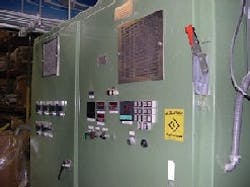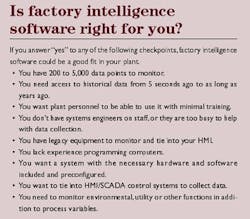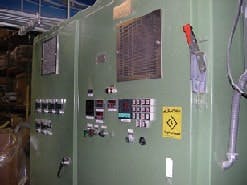Factory intelligence is your greatest weapon in the war on underefficiency
June 10, 2004
6 min read
U.S. manufacturers continue to invest heavily in lean manufacturing, quality initiatives and continuous improvement programs to boost performance and profitability. Yet, they still battle manufacturing inefficiencies. Investing millions in front-office operations doesn't mean companies can simply ignore their factories, which are the source of their profits.Many companies have invested in sophisticated technology, such as human machine interface (HMI) and supervisory control and data acquisition (SCADA) packages, specifically to help better visualize and control manufacturing processes. None of these systems inherently stores the historical data needed to troubleshoot faults, machine failures and process issues. Although these systems are good at showing real-time data, their trending capability often is too cumbersome and complex to put into everyday use.As a result, many fly blind, with virtually no information about how their equipment is performing. Beyond what they can see or touch, there's no tangible data with which to troubleshoot faults and product quality issues, or to support recommendations for improving productivity.
Seeing the forest
What companies need is a way to monitor machine and process parameters continuously, as well as a way to store data for analysis. In short, critical process information should be at your fingertips so you can 'see the forest for the trees.While an HMI or SCADA system is designed to act as an operator interface for the control system and to monitor data in real time, both have limited data storage capability. When a manufacturing line fails, the HMI or SCADA system can't report information about past events.So, how does one find diagnostic data? Although one approach is to buy an expensive data historian system and hire a systems engineer to configure and run it, many companies don't require such sophistication to get the data they need. Instead, factory intelligence software, a new class of technology, works effectively with or without an HMI.Unlike traditional data collection and data historian systems, factory intelligence software is designed for plant maintenance and engineering personnel. It allows them to monitor product quality, machine faults, utility usage and environmental factors that affect production. The software gathers information by linking to each HMI, PLC, I/O module and existing process control system — in any combination — to monitor and track critical process information. It can even gather data from legacy equipment.
Factory intelligence software monitors critical machine functions, such as motor current, motor speed, faults, temperature, equipment speed and pressure. It monitors pressure in plant air and hydraulic systems, as well as electrical and water consumption. After a user inputs excursion limits, any wandering process variable triggers an alarm that's logged and stored by date and time. The system monitors changes continuously and stores the information until it's needed.Right from the source
What companies need is a way to monitor machine and process parameters continuously, as well as a way to store data for analysis. In short, critical process information should be at your fingertips so you can 'see the forest for the trees.While an HMI or SCADA system is designed to act as an operator interface for the control system and to monitor data in real time, both have limited data storage capability. When a manufacturing line fails, the HMI or SCADA system can't report information about past events.So, how does one find diagnostic data? Although one approach is to buy an expensive data historian system and hire a systems engineer to configure and run it, many companies don't require such sophistication to get the data they need. Instead, factory intelligence software, a new class of technology, works effectively with or without an HMI.Unlike traditional data collection and data historian systems, factory intelligence software is designed for plant maintenance and engineering personnel. It allows them to monitor product quality, machine faults, utility usage and environmental factors that affect production. The software gathers information by linking to each HMI, PLC, I/O module and existing process control system — in any combination — to monitor and track critical process information. It can even gather data from legacy equipment.
|
View more software content on PlantServices.com |
Factory intelligence software monitors, records and stores machine and proces parameters continuously from every production line on the factory floor.Decision support
Knowing more about the effect of process variables on product quality yields better results. Factory intelligence software shines a bright light on the direct connection between process variables and product quality. It's an investigative tool that pinpoints the variable responsible for a product defect that appeared months ago.Manufacturing processes are complex, and improving them requires analysis. Software will never replace an experienced maintenance manager, but it can help do the job better. When a product is out of spec, software logs can indicate how fast the product ran and what machine produced it and when — information that's necessary, but not sufficient, to explain the situation.You need to know the values of the process variables at the moment the product was manufactured if you are to identify which specific change affected quality. Without this intelligence, someone would have to watch the production line or use a chart recorder with limited inputs to catch the deviation and its cause.When the line is down
Machines break down regardless of how much preventive maintenance they receive. A plant can have the most sophisticated software, but if it can't monitor critical manufacturing parameters, it's powerless to correct or prevent downtime. A factory intelligence system, on the other hand, monitors data points continuously, recording the information for troubleshooting a failure.Let's say a line is down and the operators have no idea why. The machine operator isn't able to shed any light on the problem. To further complicate matters, the HMI is filled with obscure fault messages and isn't tracking the variables needed. This would normally be the point at which the trusty multimeter goes into action.Factory intelligence software, however, can access and send the entire list of machine and process variables for the several hours preceding the failure to any online PC. In a matter of seconds, it reveals a list of alarms and related trending information. Armed with good data, you can identify the root cause malfunction and go about your normal business.Tools for PMOne technology that is getting a lot of press is computerized maintenance management software (CMMS). It logs the maintenance performed and schedules predictive maintenance, the idea being that more predictive maintenance prevents failures. But that software can't prevent line failures because it doesn't pull the data needed for root cause analysis. Because factory intelligence software tracks and stores every piece of historical data, it can be used in conjunction with a CMMS to trigger advisory or emergency work orders. At the touch of a button, you can review 'out of specification'alarms at will to determine potential problem areas and when proactive maintenance shutdowns should be scheduled. In addition, you can pull real-world examples from the system to use for training purposes.Solving a maintenance or production problem under pressure is stressful. Documenting the causes and remedies is usually done last, if at all. A CMMS alone won't show what caused a failure. Losing experienced personnel and their undocumented knowledge can make training difficult, if not impossible. Factory intelligence software provides a history of events leading to a failure and the corrective actions taken.Better efficiency
Storing historical manufacturing data improves operator efficiency by clearly showing the relationship between operator activity and production results. It explains cause and effect, and can instruct personnel about ways to improve production performance.
Knowing more about the effect of process variables on product quality yields better results. Factory intelligence software shines a bright light on the direct connection between process variables and product quality. It's an investigative tool that pinpoints the variable responsible for a product defect that appeared months ago.Manufacturing processes are complex, and improving them requires analysis. Software will never replace an experienced maintenance manager, but it can help do the job better. When a product is out of spec, software logs can indicate how fast the product ran and what machine produced it and when — information that's necessary, but not sufficient, to explain the situation.You need to know the values of the process variables at the moment the product was manufactured if you are to identify which specific change affected quality. Without this intelligence, someone would have to watch the production line or use a chart recorder with limited inputs to catch the deviation and its cause.When the line is down
Machines break down regardless of how much preventive maintenance they receive. A plant can have the most sophisticated software, but if it can't monitor critical manufacturing parameters, it's powerless to correct or prevent downtime. A factory intelligence system, on the other hand, monitors data points continuously, recording the information for troubleshooting a failure.Let's say a line is down and the operators have no idea why. The machine operator isn't able to shed any light on the problem. To further complicate matters, the HMI is filled with obscure fault messages and isn't tracking the variables needed. This would normally be the point at which the trusty multimeter goes into action.Factory intelligence software, however, can access and send the entire list of machine and process variables for the several hours preceding the failure to any online PC. In a matter of seconds, it reveals a list of alarms and related trending information. Armed with good data, you can identify the root cause malfunction and go about your normal business.Tools for PMOne technology that is getting a lot of press is computerized maintenance management software (CMMS). It logs the maintenance performed and schedules predictive maintenance, the idea being that more predictive maintenance prevents failures. But that software can't prevent line failures because it doesn't pull the data needed for root cause analysis. Because factory intelligence software tracks and stores every piece of historical data, it can be used in conjunction with a CMMS to trigger advisory or emergency work orders. At the touch of a button, you can review 'out of specification'alarms at will to determine potential problem areas and when proactive maintenance shutdowns should be scheduled. In addition, you can pull real-world examples from the system to use for training purposes.Solving a maintenance or production problem under pressure is stressful. Documenting the causes and remedies is usually done last, if at all. A CMMS alone won't show what caused a failure. Losing experienced personnel and their undocumented knowledge can make training difficult, if not impossible. Factory intelligence software provides a history of events leading to a failure and the corrective actions taken.Better efficiency
Storing historical manufacturing data improves operator efficiency by clearly showing the relationship between operator activity and production results. It explains cause and effect, and can instruct personnel about ways to improve production performance.
Ron Iannacone is president of FIN LLC, West Berlin, N.J. Contact Ron at [email protected] and (888) 405-4017.
Figures: FIN LLC
Figures: FIN LLC
About the Author
Ron Iannacone
Ron Iannacone
Sign up for our eNewsletters
Get the latest news and updates



